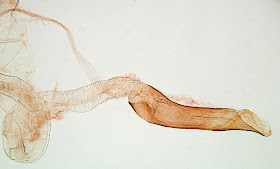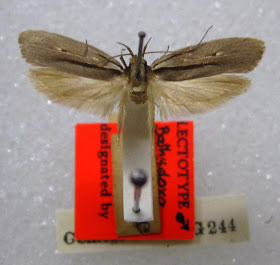Bathydoxa Turner, 1935
Bathydoxa Turner, 1935. Revision of Australian Lepidoptera. Oecophoridae. IV. Proceedings of the Linnean Society of New South Wales, 60: 315–339 [330]. Type species: Bathydoxa euxesta Turner, 1935 by original designation. (Edwards, 2003).
Bathydoxa Turner, 1935. Proceedings of the Linnean Society of New South Wales, 60: 1–15 [3] [nom. nud.].
Bathydoxa Turner, 1935. Common, in Nielsen, E.S., Edwards, E.D. & Rangsi, T.V. 1996. Checklist of the Lepidoptera of Australia. Monogr. Aust. Lepid. 4: i–xiv, 1–529 & CD–ROM [86, 346: Note #125].
Bathydoxa Turner, 1935. [Oecophoridae] Beccaloni, G. W., Scoble, M. J., Robinson, G. S. & Pitkin, B. (Editors). 2003. The Global Lepidoptera Names Index (LepIndex). World Wide Web electronic publication. http://www.nhm.ac.uk/entomology/lepindex [accessed 7 April 2010].
Bathydoxa Turner, 1935. Edwards, E. D. (2003), Xyloryctinae. Australian Faunal Directory. Australian Biological Resources Study, Canberra. http://www.environment.gov.au/biodiversity/abrs/online-resources/fauna/afd/taxa/XYLORYCTINAE [accessed 13 June 2010].
Bathydoxa Turner, 1935. [Oecophoridae, Oecophorinae] B. Pitkin and P. Jenkins, Butterflies and Moths of the World: Generic Names and their Type-species, 2004. World Wide Web electronic publication. http://www.nhm.ac.uk/research-curation/research/projects/butmoth/ [accessed 7 April 2010]
Original description, Turner 1935
Gen. Bathydoxa, n.g.
βαθυδοξος, far-famed. (Turner, 1935).
Tongue strong. Palpi very long; second joint three times length of face, thickened with appressed scales, slightly rough anteriorly; terminal joint shorter: slender, acute. Antennae without basal pecten; in male moderately ciliated. Thorax smooth. Forewings with 7 to apex. Hindwings normal.
Distinguished by the very long palpi together with the absence of antennal pecten. Type, B. euxesta.
Other references:
125. Bathydoxa Turner, May 1935, nomen nudum. First published after 1930 by Turner (1935a (May): 3) in a key to genera, without the designation of a type species, this name was not nomenclaturally available (Article 13(b)) until the genus was formally described by Turner (1935b (December): 330), with Bathydoxa euxesta Turner designated as the type species. (Common, 1996, in Nielsen, E.S., Edwards, E.D. & Rangsi, T.V. 1996. Checklist of the Lepidoptera of Australia. Monogr. Aust. Lepid. 4: i–xiv, 1–529 & CD–ROM [346: Note #125]. (Nielsen, E.S., Edwards, E.D. & Rangsi, T.V. 1996).
Description:
Head:
Thorax:
Abdomen:
Immature stages:
Distribution: New South Wales, Queensland, Victoria. Endemic. (Edwards, 2003).
_____________________________________
Bathydoxa euxesta Turner
Bathydoxa euxesta Turner, 1935. Revision of Australian Lepidoptera. Oecophoridae. IV. Proceedings of the Linnean Society of New South Wales, 60: 315–339 [330]. Syntype(s) ANIC 5♂♀, Toowoomba, Qld; Mittagong, NSW.
Bathydoxa euxesta Turner, 1935. Common, in Nielsen, E.S., Edwards, E.D. & Rangsi, T.V. 1996. Checklist of the Lepidoptera of Australia. Monogr. Aust. Lepid. 4: i–xiv, 1–529 & CD–ROM [86, 346: Note #125].
Bathydoxa euxesta Turner, 1935. [Oecophoridae] Beccaloni, G. W., Scoble, M. J., Robinson, G. S. & Pitkin, B. (Editors). 2003. The Global Lepidoptera Names Index (LepIndex). World Wide Web electronic publication. http://www.nhm.ac.uk/entomology/lepindex [accessed 7 April 2010].
Bathydoxa euxesta Turner, 1935. Edwards, E. D. (2003), Xyloryctinae. Australian Faunal Directory. Australian Biological Resources Study, Canberra. http://www.environment.gov.au/biodiversity/abrs/online-resources/fauna/afd/taxa/XYLORYCTINAE [accessed 13 June 2010].
Bathydoxa euxesta Turner, 1935. [Oecophoridae, Oecophorinae] B. Pitkin and P. Jenkins, Butterflies and Moths of the World: Generic Names and their Type-species, 2004. World Wide Web electronic publication. http://www.nhm.ac.uk/research-curation/research/projects/butmoth/ [accessed 7 April 2010]
Original description, Turner, 1935
Bathydoxa euxesta, n. sp.
ευξεστος, smooth.
♂,♀. 24-30 mm. Head grey. Palpi grey, rather whitish. Antennae grey; ciliations in male 1 ½. Thorax grey; tegulae fuscous. Abdomen pale ochreous-grey. Legs pale grey. Forewings elongate, costa rather strongly arched, apex pointed, termen straight, oblique; grey; costal edge grey-whitish; a blackish subcostal streak from base of costa to one-fourth; a broader subdorsal streak from base to three-fourths; discal stigmata represented by a fine longitudinal streak, sometimes interrupted, edged beneath with whitish; cilia grey. Hindwings grey, towards base paler; cilia grey.
Queensland: Brisbane; Toowoomba, in December and February. New South Wales: Mittagong, in December. Five specimens.
Diagnosis:
Description:
Head:
Thorax:
Abdomen:
-->  |
| Bathydoxa euxesta, ♂ genitalia. Brisbane. ANIC slide no. G244, dissected by I.F.B. Common, 1958. Photomicrograph taken at ANIC, Canberra. |
 |
| Bathydoxa euxesta, aedeagus. Brisbane. ANIC slide no. G244, dissected by I.F.B. Common, 1958. Photomicrograph taken at ANIC, Canberra. |
Food plants:
Flight period: December, February.
Distribution: New South Wales, Queensland, Victoria. Endemic. (Edwards, 2003).
Remarks: The male gentitalia resemble those of the Lecithoceridae.
I would like to return Leistarcha tenuistria to the genus Bathydoxa.
I would like to return Leistarcha tenuistria to the genus Bathydoxa.
Bathydoxa tenuistria Turner, 1935
Bathydoxa tenuistria, QM, holotype, labels.
Bathydoxa tenuistria, ANIC
Bathydoxa tenuistria Turner, 1935 [Oecophoridae], Revision of Australian Lepidoptera. Oecophoridae. IV. Proceedings of the Linnean Society of New South Wales, 60: 315–339 [330]. Holotype QM ♂, Toowoomba, Qld.
Leistarcha tenuistria (Turner, 1935), comb. n. Common, in Nielsen, Edwards, & Rangsi, 1996, Checklist of the Lepidoptera of Australia. Monographs on Australian Lepidoptera, 4: i-xiv, 1-529 & CD-ROM [87].
Bathydoxa tenuistria Turner, 1935 [Oecophoridae]. Beccaloni, G. W., Scoble, M. J., Robinson, G. S. & Pitkin, B. (Editors). 2003. The Global Lepidoptera Names Index (LepIndex). World Wide Web electronic publication. http://www.nhm.ac.uk/entomology/lepindex [accessed 22 April 2010].
Leistarcha tenuistria (Turner, 1935), Edwards, E. D. (2003), Xyloryctinae. Australian Faunal Directory. Australian Biological Resources Study, Canberra. http://www.environment.gov.au/biodiversity/abrs/online-resources/fauna/afd/taxa/XYLORYCTINAE [accessed 17 June 2010].
Original description, Turner 1935
Bathydoxa tenuistria, n. sp.
tenuistrius, finely streaked.
♂ 30 mm. Head and face fuscous with fine lateral white lines. Palpi rather densely sprinkled with whitish. Antennae fuscous; ciliations in male 1 ½. Thorax fuscous with fine central and lateral white lines. Abdomen ochreous-fuscous, apices of segments grey-whitish. Legs fuscous; inner surface whitish; posterior pair whitish. Forewings elongate, narrow, costa moderately arched, apex pointed, termen very oblique; fuscous, with numerous fine white longitudinal streaks; these are closely applied so as to form costal median and dorsal bundles; from end of cell these are replaced by two broad bundles, first to apex end of costa, second to lower two-thirds of termen; cilia grey traversed by extremities of the white streaks. Hindwings and cilia grey.
Queensland: Toowoomba, in November; one specimen received from Mr. W. B. Barnard, who has the type.
Diagnosis:
Description:
Head:
Thorax:
Abdomen:
Food plants:
Flight period: New South Wales, Queensland, Victoria. Endemic. (Edwards, 2003).
Distribution:
Remarks:
Genetic evidence has seen Leistarcha moved to the Oecophoridae. Bathydoxa (so far) remains behind on the Xyloryctidae.
Evidence from genitalia dissection shows a similarity between tenuistria and euxesta. Both are distictively different from Leistarcha.
Evidence from genitalia dissection shows a similarity between tenuistria and euxesta. Both are distictively different from Leistarcha.
Updated 15 September 2019.




